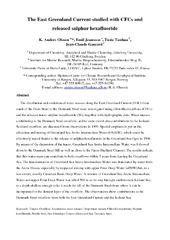The East Greenland Current studied with CFCs and released sulphur hexafluoride
Journal article

View/
Date
2005-03Metadata
Show full item recordCollections
- Geophysical Institute [1198]
Abstract
The distribution and evolution of water masses along the East Greenland Current (EGC) from south of the Fram Strait to the Denmark Strait were investigated using chlorofluorocarbons (CFCs) and the released tracer sulphur hexafluoride (SF6) together with hydrographic data. Water masses contributing to the Denmark Strait overflow, and to some extent also contributions to the Iceland-Scotland overflow, are discussed from observations in 1999. Special emphasis is put on the advection and mixing of Greenland Sea Arctic Intermediate Water (GSAIW), which could be effectively traced thanks to the release of sulphur hexafluoride in the Greenland Sea Gyre in 1996. By means of the dispersion of the tracer, Greenland Sea Arctic Intermediate Water was followed down to the Denmark Strait Sill as well as close to the Faroe-Shetland Channel. The results indicate that this water mass can contribute to both overflows within 3 years from leaving the Greenland Sea. The transformation of Greenland Sea Arctic Intermediate Water was dominated by water from the Arctic Ocean, especially by isopycnal mixing with upper Polar Deep Water (uPDW) but, to a less extent, also by Canadian Basin Deep Water. A mixture of Greenland Sea Arctic Intermediate Water and upper Polar Deep Water was lifted 500 m on its way through southwestern Iceland Sea, to a depth shallow enough to let it reach the sill of the Denmark Strait from where it can be incorporated in the densest layer of the overflow. The observations show contributions to the Denmark Strait overflow from both the East Greenland Current and the Iceland Sea.